Einfluss von Kohlenstoffnanoröhren und ihren Derivaten auf Tumorzellen in vitro und biochemische Parameter, zelluläre Blutzusammensetzung in vivo
Zusammenfassung
Ziel der vorgeschlagenen Arbeit war es, die Toxizität von oxidierten Kohlenstoffnanoröhren (CNTox), die durch Doxorubicin (CNT-Dox) und Fluorescein (CNT-FITC) funktionalisiert werden, auf Zell- und Organismusebene zu analysieren. Die zytotoxische Wirkung von CNTox, CNT-Dox und CNT-FITC wurde an Tumorzellen in vitro (2-D, 3-D-Kulturen) und an Balb2/c-Mäusenmodellen in vivo analysiert. Als Ergebnis wurde die Möglichkeit der Doxorubicin-Immobilisierung auf der CNT-Oberfläche und der kontrollierten Freisetzung von Doxorubicin (Dox) von der CNT-Oberfläche demonstriert. Dox-Immobilisierung fällt zusammen mit abnehmender zytotoxischer Wirkung CNT-Dox im Vergleich zu freiem Dox. Der Abbau von Peptidbindungen mit der CNT-Oberfläche führte zur Freisetzung von Doxorubicin und einer dosisabhängigen Verstärkung der zytotoxischen Wirkung von CNTs und Dox. Die kombinierte zytotoxische Wirkung von CNTs, Dox und Trypsin auf das Überleben von Tumorzellen wurde gezeigt. Auf Organismusebene wurde die Wirkung der erhaltenen Nanostrukturen auf den Zustand des Leberenzymsystems, den Proteinstoffwechsel und die Zellblutzusammensetzung der Versuchstiere untersucht. Der CNTox-Einfluss im In-vivo-Modell war statistisch der gleiche wie bei der Kontrolle. CNT-Dox zeigte im Vergleich zu reinem Doxorubicin eine geringere toxische Wirkung auf den gesamten Organismus. Abweichungen in der Zellblutzusammensetzung deuteten auf eine allgemein toxische Wirkung von CNT-Dox hin, die jedoch im Vergleich zu reinem Doxorubicin moderater war. Aus den erhaltenen Daten schlossen wir, dass die Bindung von CNTs mit Doxorubicin eine Verringerung der Toxizität von Doxorubicin auf die allgemeinen biochemischen Indikatoren von Blut und Verletzungen der Zusammensetzung der Blutzellen in vivo ermöglicht. Gleichzeitig ermöglichte uns die kombinierte Wirkung von CNTs und Doxorubicin nach der Wirkstofffreisetzung eine größere Wirksamkeit bei der Unterdrückung des Tumorwachstums in vitro.
Hintergrund
Eine der auffälligsten und vielversprechendsten Anwendungen von Kohlenstoff-Nanoröhrchen ist die Medizin. Kohlenstoffnanoröhren (CNTs) zeichnen sich durch einzigartige chemische und biologische Eigenschaften aus [1,2,3,4,5]. CNTs haben eine große Oberfläche, die es ihnen ermöglicht, eine Vielzahl von biologischen Substanzen zu binden [6]. Darüber hinaus können CNTs Zellmembranen und Kapillaren durchdringen und sich in Zellen und Geweben anreichern [7,8,9]. CNTs werden leicht von Zellen aufgenommen und fördern die Fähigkeit der CNTs, Zellkerne zu erreichen, und impliziert die Möglichkeit einer Gentherapie [10]. Deshalb sind CNTs attraktive Vehikel für den Transport von Proteinen, Antigenen, RNA/DNA-Vektoren [11], Impfstoffen und Medikamenten in die Zellen [12]. Besonderes Interesse gilt den Aussichten für den Einsatz von CNTs als personalisierter Träger mit kontrollierter Wirkstofffreisetzung zur Krebstherapie [13], antibakteriellen [14] und immunologischen Therapie [15]. Die gezielte Abgabe und kontrollierte Freisetzung ist das eigentliche Problem der modernen Verwendung von Arzneimitteln, insbesondere mit zytotoxischen Eigenschaften. Der genaue Mechanismus der Wirkstofffreisetzung gewährleistet eine effektive Konzentration des Wirkstoffs im Zielgewebe mit einer minimalen Konzentration in anderen. Es würde die Dosis des Arzneimittels unter Beibehaltung seiner Wirksamkeit und Verringerung des Schadens durch Nebenwirkungen reduzieren. Derzeit gibt es verschiedene Wege der gezielten Wirkstoffabgabe, wie die Abgabe unter Verwendung von Liposomen [16], polymeren Micellen und Dendrimeren [17], biologisch abbaubaren Partikeln [18] und anderen Nanopartikeln [19]. Jüngste Experimente haben jedoch viele Vorteile der Verwendung von CNTs bei der Verabreichung von Medikamenten im Vergleich zu anderen Nanopartikeln gezeigt [20, 21]. Eine davon sind CNTs mit ziemlich großer und aktiver Oberfläche, die mit der gewünschten chemischen Substanz gefüllt werden können, von kleinen Molekülen bis hin zu Proteinen, Antikörpern und RNA/DNA. Offene Enden von CNTs machen das innere Volumen und die Oberfläche für die Funktionalisierung zugänglich. Die große Oberfläche von CNTs bietet also viele Bindungsstellen für verschiedene Arten von Funktionalisierungen. Gleichzeitig mit den Aussichten von CNTs gibt es einige Probleme mit der geringen Löslichkeit von CNTs, der Aggregationsfähigkeit, hydrophilen Eigenschaften, der langen Halbwertszeit und dem Einfluss auf den gesamten Organismus [22]. Laut Literatur geht die Einführung von CNTs in den Körper von Versuchstieren mit einer Akkumulation von CNT und seinen Derivaten in den Organen des Verdauungstraktes, der Milz, der Nieren [23], der Muskeln [24] und des Lungengewebes [25] einher. . Im nächsten Schritt beeinflussen CNTs die Aktivität von Stoffwechsel- und Entzündungsprozessen [25, 26], den Zustand des Immunsystems [27] und das Überleben von Versuchstieren [28]. Dennoch sind diese Probleme Gegenstand aktiver Forschung, um die Verwendung von Kohlenstoffnanoröhren weiter voranzutreiben. Die Vorteile von CNTs als Nanovektoren für den Wirkstofftransport wurden in einer Reihe von Studien überzeugend nachgewiesen. Autoren von [29, 30] berichteten, dass bestimmte Nanoröhren möglicherweise weniger schädlich sind als Nano-Träger für Medikamente. Es wurde auch gezeigt, dass eine einfache Funktionalisierung (-OH, -COOH, -NH, PEG) [31] oder Verkapselung der CNTs [22] die Wasserlöslichkeit erhöht, die Bioverfügbarkeit verbessert und die Toxizität von CNTs reduziert. Und die Einführung von CNTs in Mäuse mit einem transplantierten Tumor kann gegen gezieltes transformiertes Gewebe wirksam sein und zu einer Verringerung des Tumorvolumens und zu einer Erhöhung des Überlebens der Tiere führen [32].
Aufgrund früherer Untersuchungen [33] nahmen wir an, dass eine aktive Antitumorsubstanz (Doxorubicin) auf der Oberfläche von Carbon-Nanotube-Peptidbindungen immobilisiert werden könnte. Die resultierende Verbindung, Kohlenstoff-Nanoröhrchen, die durch Doxorubicin (CNT-Dox) funktionalisiert wurden, könnte die zytotoxischen Eigenschaften von CNT als Doxorubicin (Dox) reduzieren. Gleichzeitig kann der Zerfall des behandelten Konstrukts die Realisierung der zytotoxischen Eigenschaften von CNT und Dox ermöglichen. Dadurch ist es möglich, die Antitumorwirkung beider Substanzen zu steigern. Daher war das Ziel der vorliegenden Studie, die zytotoxische Wirkung des CNTs-Dox-Konstrukts in Gegenwart von Protease (Trypsin) in vitro zu bestimmen. Wir analysierten den Einfluss von CNTs und ihren Derivaten auf Tumorzellen in 2D- und 3D-Zellmodellen in vitro. Das andere Ziel war es, den Einfluss der erhaltenen Verbindungen (CNTs, CNTox und CNT-Dox) auf die Aktivität des Leberenzymsystems, den Proteinumsatz und die zelluläre Blutzusammensetzung in vivo zu untersuchen. So realisierten die Autoren eine komplexe Abschätzung der Toxizität, Bioverfügbarkeit und Wirksamkeit der Verwendung von CNTs und ihren Derivaten gegen Tumoren des Magen-Darm-Trakts.
Methoden
Die Zelllinie des kaukasischen Kolon-Adenokarzinom-Grad-II-Karzinoms (HT29) wurde als experimentelles Zellmodell im 2D (Monolayer) und 3D (Sphäroid) System in vitro verwendet. Die Linie wurde vom Institut für experimentelle Pathologie, Onkologie und Radiobiologie der Bank für Zelllinien und Tiergewebe Kavetsky, NAS Ukraine, erworben. Die Zellen wurden unter Standard-Zellkulturbedingungen (95 % Luftfeuchtigkeit, 5 % CO2 .) gehandhabt in der Luft; 37 °C) in DMEM-Vollmedium mit 10 % FBS unter Laborsicherheitsstufe 2.
Synthese, Oxidation und Funktionalisierung von CNT
Die ersten mehrwandigen Kohlenstoffnanoröhren (MWCNTs) wurden durch chemische Gasphasenabscheidung (Propylen und Wasserstoff mit Mo/Fe/Al2 .) erhalten O3 als Katalysator). Synthetisierte MWCNTs hatten 10–30 Schichten, Innendurchmesser 5–15 nm, Außendurchmesser 10–60 nm, Länge 20–500 μm, spezifische Oberfläche 120 m 2 /g und Schüttdichte 5–50 g/l [33].
Die Reinigung von MWCNTs vom Metall/Katalysator wurde durch HF-Behandlung durchgeführt. Die Eliminierung von amorphem Kohlenstoff aus Kohlenstoffnanomaterialien wurde durch Oxidation an Luft bei 450–500 °C realisiert. Die MWCNTs enthaltende Rohprobe reagierte mit Sauerstoff aus der Luft und erzeugte Kohlendioxid oder Kohlenmonoxid. Eine gewisse Menge an Kohlenstoffablagerungen wurde erhalten, nachdem der Katalysatorträger in HF (Wasser) gelöst wurde und bei 450–500 °C in Luft oxidiert wurde. Für dieses Verfahren wurde für 130–150 min ein Quarzrohrreaktor mit Luftstrom verwendet. In früheren Arbeiten haben wir die physikalischen und chemischen Eigenschaften der erhaltenen MWCNTs analysiert und beschrieben [33].
Rasterelektronenspektroskopie (REM) von MWCNTs (JEOL SL6060LA, Japan) wurde verwendet, um die strukturellen Eigenschaften von MWCNTs zu bestimmen. Nach der Immobilisierung der Liganden wurde die Morphologie nicht verändert.
Oxidation von MWCNTs
Im nächsten Schritt wurden die gereinigten Kohlenstoffnanoröhren (CNTs) in 70 % HNO3 . oxidiert bei 99 °C für 4 h und dann mit destilliertem Wasser und 10 % NH4 . gewaschen OH-Lösung für 12 h. Als Ergebnis wurden Kohlenstoff-Nanomaterial-Oxide MWCNTox (CNTox) synthetisiert. Danach wurden die CNTs dreimal mit dH2 . gewaschen 0 bis neutraler pH-Wert. Die sauren Stellen auf der CNT-Oberfläche wurden mit 0,1 M HCl-Lösung regeneriert. Die resultierenden oxidierten CNTs-ox wurden durch Zentrifugation abgetrennt, gründlich gespült und in dH2 . resuspendiert O Wasser.
Vorbereitung von CNT-Dox-Partikeln
Die Aufgabe des nächsten Schrittes bestand darin, Dox-Hydrochlorid (Dox, Teva Nederland B.V., Niederlande) auf der Oberfläche von MWCNTs-Partikeln zu immobilisieren. Um die Oberflächen von oxidierten CNTs (200 mg) mit aminohaltigem Dox-Lactose-Monohydrat zu funktionalisieren, wurden sie mit einem bifunktionellen Verknüpfungsmittel – N-Cyclohexyl-N′-(2-morpholinoethyl)carbodiimid-metho-p-toluolsulfonat (C 1011, Sigma Aldrich .) inkubiert , USA) während 15 min bei Raumtemperatur (Abb. 1a). Danach wurden 100 mg DOX-Lactose-Monohydrat in 10 ml 0,15 M Phosphatpuffer pH 6,5 zu jedem Nanokohlenstoff-Material gegeben. Die Mischung wurde 24 h bei 30 °C reagieren gelassen. Unter solchen Bedingungen wurden kovalente Bindungen zwischen Dox und CNTs gebildet (Abb. 1b). Die Zusammensetzung wurde durch Zentrifugation bei 10.000 U/min 15 min gesammelt und mit dH2 . gewaschen Oh dreimal. Die Überstände wurden zum Nachweis der Konzentration von freiem DOX durch ein Spektrophotometer verwendet. Die Immobilisierung von FITS auf der CNT-Oberfläche wurde durch das in Abb. 2a, b gezeigte Schema bereitgestellt.
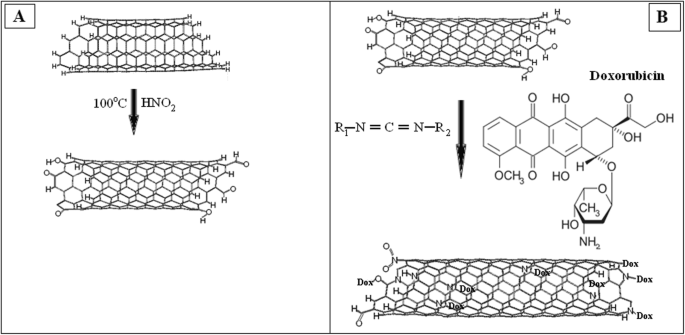
a Reaktionsschema von CNTs mit Carbodiimid. b Schema der Funktionalisierung der CNTs durch Doxorubicin
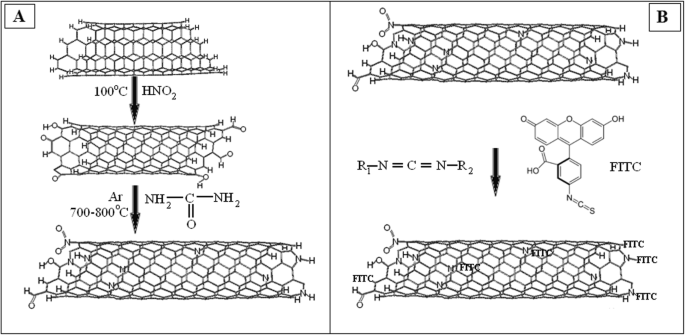
a Reaktionsschema von CNTs mit Harnstoff. b Schema der Funktionalisierung der CNTs durch FITC
Vorbereitung stabiler Aussetzungen von MWCNTs
Die kolloidale Suspension von MWCNTs wurde in zwei Stufen durchgeführt. In der ersten Stufe wurden Kohlenstoff-Nanomaterialien einer Ultraschallbehandlung in Phosphat-Salz-Puffer (PBS) mit einem Ultraschall-Dispergiergerät UZDN-2 T unterzogen. Die Verarbeitungsmodi waren I = 10 mA, R = 22 kHz, Dauer 30 Minuten. In der zweiten Stufe wurde das resultierende Hydrosol durch Zentrifugation bei Raumtemperatur dispergiert. Das Verfahren umfasst mehrere Zentrifugationszyklen. Daher wurde die hydrophile, sich auflösende SWCNTs-Fraktion auf diese Weise ausgewählt. Vor der Zugabe zu den in Suspension kultivierten Zellen wurden Lösungen von MWCNTs durch Kochen für 30 Minuten sterilisiert. Derivate von CNTs (CNT-Dox und CNT-FITC) wurden durch die 100-fache Konzentration von PSGA (Penicillin:Streptomycin:Gentamycin:Amphotericin) sterilisiert.
Zeta-Potenzial von Suspensionen von Nanoröhren
Das Zetapotential der Proben wurde durch elektrophoretische Lichtstreuung (M3-PALS) gemessen. Für Messungen wurde der Zetasizer Nano ZS-Analysator, hergestellt von Malvern Instruments (Malvern, UK), verwendet. Die Experimente wurden bei 25 °C mit sieben Wiederholungen durchgeführt. Zur Messung der Proben wurden eine universelle Tauchelektrode (Universal Dip Cell) ZEN1002 und Polystyrolküvetten (DTS001), eine Lichtquelle – ein H-Ne 633 nm-Laser, verwendet.
FTIR-Spektroskopie
Die chemische Zusammensetzung der erhaltenen Nanomaterialien wurde mittels Fourier-Transform-Infrarot-(FTIR)-Spektroskopie untersucht. IR-Spektren wurden mit dem FTS 7000e Varian FTIR-Spektrometer bestimmt. Proben für die Analyse wurden hergestellt, indem in einer Mühle eine Mischung von ~ 1 mg CNTs und 150 mg spektral reinem KBr gemahlen wurde. Die Proben wurden unter Verwendung einer Presse mit einer Druckkraft von 3,0–3,5 × 10 3 . hergestellt kg/cm 2 . Die Proben wurden durch Erhitzen auf eine Temperatur von 600 °C für 60 Minuten entwässert. Pre-Shot-Spektren von KBr wurden vorläufig erhalten, danach wurden sie von den Spektren der Proben abgezogen. Alle Spektren wurden gemäß dem Katalog zur spektrometrischen Identifizierung organischer Verbindungen [34] analysiert. Zum Vergleich wurden Proben von oxidierten MWCNTs (CNT-O), von Doxorubicin funktionalisierten MWCNTs (CNT-D) und von Fluoreszenzmarkierungen funktionalisierten MWCNTs (CNT-F) verwendet. Alle Verarbeitungs- und Bedingungen, von Proben und Konzentration, waren für drei Materialien gleich.
Kolorimetrischer Assay zur Freisetzung von Doxorubicin von der Oberfläche von CNTs
Um die Menge an freiem Dox nach Immobilisierung auf CNMs und die Wirksamkeit der Dox-Freisetzung zu bewerten, wurde die Fähigkeit von freiem Dox zur Fluoreszenz bei einer Wellenlänge von 495 nm verwendet [35]. Die aktive Konzentration von Dox in Dox-Hydrochlorid betrug 16,7% w /w . Zum Zeichnen der Kalibrierlinien Dox Teva 20 mg/ml mit zehn Verdünnungen auf 8 × 10 −3 mg/ml wurde verwendet. Dann wurde die Fluoreszenz von freiem Dox im Überstand von Komplexen DOX mit CNTs mit einem spektrophotometrischen Plattenlesegerät Multiscan (Labsystem, Finnland) gemessen.
Funktionsgruppenkonzentration in CNT-DOX-, CNT-FITC-Partikeln
Für Dox-Immobilisierungen 1 g MWCNTs in 1 ml dH2 O wurde verwendet. Die Dox-TEVA-Menge betrug 100 mg (16,7 mg aktives Dox) in 1 ml dH2 O. Die Menge an freiem Dox im Überstand nach der Reaktion betrug 0,37 mg oder 2,2 % aus Wirkstoffen. Daher kamen wir zu dem Schluss, dass 16,23 mg DOX auf 1 g CNTox immobilisiert waren. Für FITC war der Prozentsatz der Immobilisierung gering. Anschließend wurden 8,35 mg FITC auf 1 g CNTox in 1 ml dH2 . immobilisiert O. Die Effektivität der Funktionalisierung betrug 1,62% w /w für CNT-DOX und 0,84% w /w für CNT-FITC. Die weitere Berechnung der Konzentrationen CNT-Dox und CNT-FITC basiert auf diesen Daten.
Zytotoxischer Assay von CNT-Derivaten im 2-D- und 3-D-Zellmodell
Die Zytotoxizität von Dox, CNTs, CNT-FITC und CNT-Dox wurde unter Verwendung des MTT-Assays gegen HT29-Tumorzellen bewertet. MTT-Test basierend auf der Umwandlung von 3-[4,5-Dimetltiazol-2]-2,5-dipheniltetratetrazoliumsalzen in Formazankristalle durch NAD(P)H-abhängige mitochondriale Oxidoreduktase-Enzyme in lebenden Zellen. Das Protokoll wurde von T. Mosmann [36] beschrieben. Kurz gesagt, 1 × 10 4 HT29 wurden in 96-Well-Platten ausgesät und 12 h in Vollkulturmedium kultiviert. Dann wurde das aktuelle Kulturmedium durch ein Kulturmedium ersetzt, das CNTox (Probe #1), MWCNTs (Probe #2), CNT-Dox (Probe #3), Dox (Probe #4) und CNT-FITC (Probe #5) enthielt. . Die Konzentrationen der Proben Nr. 1, 2, 3, 5 betrugen 12,5–25–50–100–200 µg/ml, die Stammkonzentration der Probe Nr. 4 betrug 20 µg/ml, die Endkonzentration 1 bis 10 µg/ml. Die Zellen wurden in Vollmedium kultiviert und als Kontrolle verwendet. Nach 24 Stunden Inkubation wurden die Zellen mit MTT durch einen kolorimetrischen Assay analysiert. Zu 100 μl Zellsuspension haben wir 20 μl MTT-Lösung (5 mg/ml PBS, Sigma) hinzugefügt. Danach wurden die Zellen 4 h lang mit MTT unter Standardbedingungen inkubiert. Dann wurden die Proben unter 1500 g während 5 Minuten zentrifugiert und der Überstand wurde extrahiert. Insgesamt wurden den Vertiefungen 10 μl DMSO (Sigma) zur Verdünnung der MTT-Kristalle und 20 μl 25 mM Glycin zugesetzt. Die Absorption der umgesetzten Lösung wurde bei 540 nm auf einem spektrophotometrischen Plattenlesegerät Multiscan (Labsystem, Finnland) gemessen.
Generierung multizellulärer Tumorsphäroide
HT29-Zellen multizelluläres Tumorsphäroid (MTS) (3D-Kultur) als Modellsystem der Tumor-Mikrometastasierung wurde nach einer etablierten Methode kultiviert, die zuvor beschrieben wurde [33]. Kurz gesagt, die Zellsuspension wurde unter Verwendung von Trypanblau gezählt und eine gleiche Anzahl von Zellen gepflanzt (5 × 10 4 Zellen/ml). Die 3D-Zellkultur wurde in DMEM (Sigma, USA) Medium mit 10 % FBS (Sigma, USA) unter Standardbedingungen (95 % Luftfeuchtigkeit, 5 % CO2 .) gehalten in Luft, 37 °C). Die Erzeugung von MTS wurde durch eine Technologie durchgeführt, die in unserem Labor entwickelt wurde. Die Kultivierung von Tumorzellen wurde für 24 h in 24-Well-Platten gehalten, die mit 1% Agar in Kulturmedium mit 0,24% Carboxy-Methyl-Cellulose beschichtet waren. Um die Abhängigkeit der Größe und Anzahl von MTS von der Konzentration und Art der CNTs zu untersuchen, wurde MTS in Gegenwart verschiedener Konzentrationen von CNTs erzeugt. Vor der MTS-Erzeugung zu den Zellkulturen wurde CNTs-Lösung in PBS der Kultur bis zur Endkonzentration zugesetzt, wie zuvor für den MTT-Assay beschrieben. Die weitere Kultivierung wurde während 48 h bei konstanter Rotation der Platten auf einem Orbitalschüttler (80 U/min) durchgeführt. Im nächsten Schritt wurden Mikrofotos mit der „Dunkelfeld“-Methode aufgenommen. Insgesamt wurden mehr als 120 Bilder erstellt. Anschließend wurde das Volumen aller MTS, die sich auf den Dateien befanden, mit dem verwendeten Programm Axio Vision Rel 4.7, Zeiss, berechnet. Wir haben die Formel von Rolf Bjerkvig verwendet:V = 0.4 ∙ a ∙ b 2 , wobei geometrische Größen der Sphäroide (b < a ) [37]. Die Visualisierung der Ergebnisse erfolgte auf einem Stemy 2000C Mikroskop, Zeiss.
Analyse des Einflusses von CNTs auf das Leberenzymsystem, den Proteinumsatz und die zelluläre Blutzusammensetzung in vivo
Die Verfahren bezüglich der Tiere und ihrer Pflege wurden der europäischen Richtlinie 2010/63 EU angepasst, die von den lokalen Ethikkommissionen für Tierversuche genehmigt wurde (Protokoll №1 21.10.2016). Um den Einfluss der gewonnenen Substanzen auf den Allgemeinzustand der Homöostase des Organismus zu analysieren, wurde eine Reihe von Experimenten in vivo durchgeführt. In-vivo-Studien wurden Mäuse der Balb/2a-Linie verwendet. Männliche und weibliche Mäuse waren in den Gruppen im Alter von 6–8 Wochen gleich, zehn für jede Gruppe. Die Mäuse wurden in Käfigen mit Stahldrahtdeckeln und Maiskolbeneinstreu gehalten und in einer kontrollierten Atmosphäre mit 12/12 Dunkel/Licht-Zyklen, einer Temperatur von 22 °C ± 3 °C und einer Luftfeuchtigkeit von 50–70 % bei freiem Zugang gehalten zu Nahrung und frischem Wasser. Somit wurden vier Gruppen von Mäusen gebildet. Gruppe 1:Intakte Tiere wurden mit 200 μl PBS, Kontrolle, behandelt. Gruppe 2:Mäuse wurden mit CNTox in einer Dosis von 1,5 mg/kg behandelt. Gruppe 3:Mäuse wurden mit CNT-DOX in einer Dosis von 1,5 mg/kg behandelt. Und in Gruppe 4 wurden Mäuse mit Doxorubicin in einer Dosis von 20 mg/kg behandelt. Mäuse erhielten über einen Zeitraum von 4 Wochen alle 3 Tage CNT parenteral in 200 μl PBS. Doxorubicin wurde einmal alle 3 Tage intraperitoneal in einer Konzentration von 20 mg/kg Körpergewicht verabreicht.
Biochemische Serumanalyse
Einen Monat später wurden die Mäuse aus dem Experiment genommen. Herzblutproben wurden sofort von toten Tieren entnommen. Den Tieren wurde gleichzeitig von 10 bis 11 Uhr Blut entnommen. Für Plasma wurde Blut 40 min bei 37 °C inkubiert und dann zentrifugiert (20 min, 2000 U/min). Anschließend wurden biochemische Parameter, Gesamtprotein, Albumin, Aspartat-Aminotransferase (AST) und Alanin-Aminotransferase (ALT), alkalische Phosphatase (ALP), im Plasma mit diagnostischen Kits (Cormay, Warschau, Polen) bestimmt. Die Experimente wurden nach einheitlichen Laborprotokollen auf dem halbautomatischen biochemischen Analysator FP-901M (Labsystems, Finnland) durchgeführt. Die zelluläre Blutzusammensetzung wurde auf einem hämatologischen Analysegerät Mindray BC-3000 Plus, China, bestimmt.
Statistische Analyse
Für die statistische Analyse der 3D-Kultur wurden alle Zellaggregate nach Größe von 1 × 10 –4 . in Gruppen einsortiert mm 3 bis 1 × 10 −2 mm 3 mit Schritt in 1 × 10 −3 mm 3 . Dann wurden die Anzahl der MTS in jeder Gruppe und der Median des MTS-Volumens für jede Gruppe geschätzt. Alle Messungen wurden dreimal wiederholt. Für normalverteilte Zufallsvariablen für Mikrostatistik-Assays haben wir den Student-Koeffizienten für eine kleine Population verwendet. Das angegebene p Wert war *р ≤ 0,05 oder **р ≤ 0.01.
Ergebnisse und Diskussion
Rasterelektronenmikroskopie von MWCNTs
Gemäß Protokoll [38] betrug der durchschnittliche Durchmesser der CNTs 10–20 nm und die durch Argondesorption bestimmte spezifische Oberfläche 200–400 m 2 /g. Schüttdichte innerhalb von 20–40 g/dm 3 . Insbesondere die Agglomerate in Form der verschlungenen Röhren mit Abmessungen von 20–500 μm werden bei einer industriellen CNT-Herstellung im CVD-Verfahren gewonnen (Abb. 3).
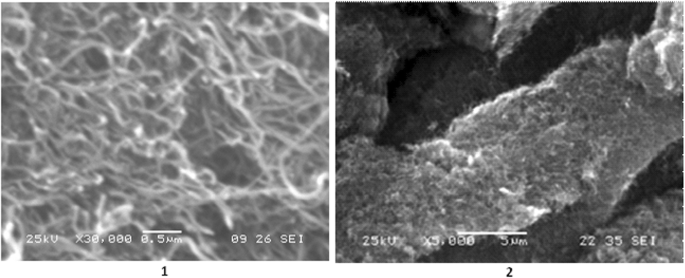
REM-Aufnahmen von CNTs, 1) Maßstab 0,5 µm; 2) Skala 5 μm
Zeta-Potenzial von Suspensionen von Nanoröhren
CNTox und CNT weisen auf eine signifikante Aggregationsstabilität hin, die direkt vom Wert des Zetapotentials abhängt. CNT-DOX hat ein kleineres Zetapotential als CNTox und CNT und eine hohe Reproduzierbarkeit der Messung, was auf die Homogenität der Partikel hinweist (Tabelle 1). Ein kleiner Wert des Zeta-Potentials von CNT-FITC kann auf signifikante Partikelgrößen oder deren geringe Konzentrationen hinweisen, was durch das hohe Rauschverhältnis bei der Messung angezeigt wird.
FTIR-Spektroskopie von CNTs, CNT-Dox und CNT-FITC
Die Bindungen zwischen CNTox und Doxorubicin (DOX) und Fluorescein (FITC) wurden auf der Grundlage von Infrarotspektraldaten geschätzt, wie in Abb. 4 gezeigt.
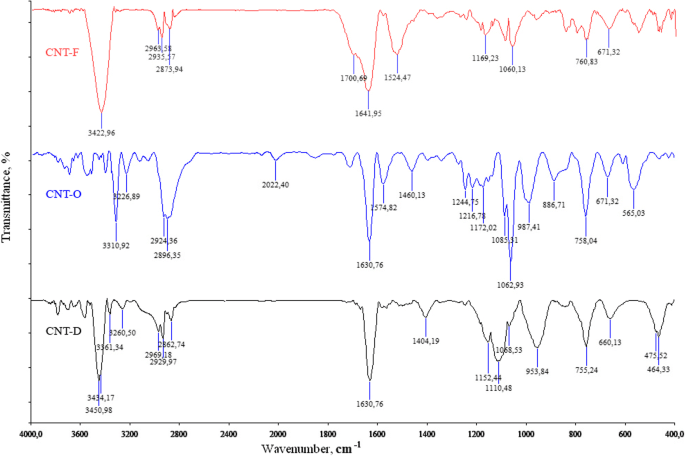
Infrarotspektren von CNTox (CNT-O), CNT-DOX (CNT-D), CNT-FITC (CNT-F)
Das Vorhandensein einer starken Bande bei υ = 3311 cm −1 (CNT-O) und υ = 3451 cm −1 (CNT-D) zurückzuführen auf die CON-H-Kopplungsfluktuationen sowie das Vorhandensein einer starken Bande bei υ = 1634 cm −1 (CNT-O) und υ = 1631 cm −1 (CNT-D) zurückzuführen auf die O-CNH-Bindungsschwingungen, was eindeutig auf die Art der Amidbindung zwischen CNT und Dox hinweist. Außerdem zeigte IR die Absorption von C-H-Bindungen, die bei 2969–2834 cm −1 . liegt und ein breites Band bei 1460–1407 cm −1 aus dem C-O-H-Fragment. Daraus können wir schließen, dass CNTs als Ergebnis chemischer Reaktionen mit einem Antitumorwirkstoff (Doxorubicin) und einem Fluoreszenzmarker (FITC) funktionalisiert wurden.
Zytotoxizität von CNTs in verschiedenen Stadien der Funktionalisierung in Monolayer- und Sphäroid-Zellwachstumsmodellen
Im nächsten Schritt wurde die Zytotoxizität von oxidierten CNTs (CNTox), mit Doxorubicin funktionalisierten CNTs (CNT-Dox) und Fluoreszenzmarkern (CNT-FITC) bestimmt. Die Ergebnisse des MTT-Tests der Monolayer-Kultur von HT29 sind in Abb. 5 dargestellt.
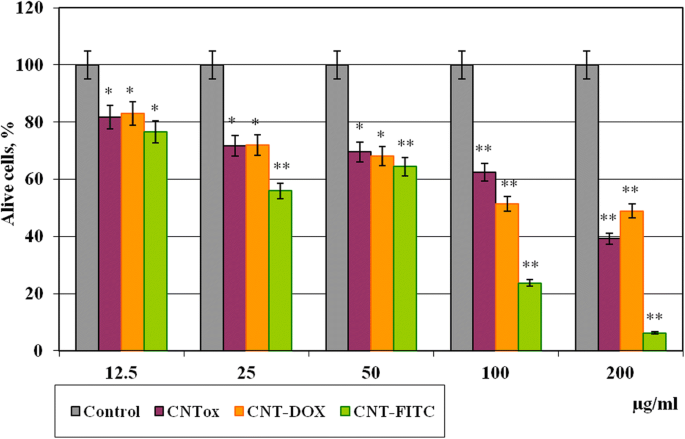
Lebensfähigkeit von Tumorzellen HT29 in Monolayer-Kultur nach 48 h Inkubation mit CNTs und ihren Derivaten (CNT-Dox und CNT-FITC). Statistische Signifikanz:*р ≤ 0,05 oder **р ≤ 0.01
Als Ergebnis wurde gezeigt, dass CNTox, CNT-Dox und CNT-FITC bei Konzentrationen von 12,5 μg/ml (81 %) eine moderate zytotoxische Wirkung haben. Eine Erhöhung der CNTox-Konzentration von 25 auf 50 bzw. 100 µg/ml führte zu einer dosisabhängigen Abnahme der Lebensfähigkeit der Tumorzellen auf 71,8–69,6–62,5% entsprechend im Vergleich zur Kontrolle. Bei einer CNTox-Konzentration von bis zu 200 μg/ml verringerte sich die Lebensfähigkeit von HT29 auf 39,2 %. Zu diesem Zeitpunkt zeigte CNT-Dox in niedrigen Konzentrationen (12,5–50 μg/ml) im Vergleich zu CNTox keine statistisch signifikante Zytotoxizität. Bei hohen Konzentrationen (200 μg/ml) hatte CTN-Dox eine noch geringere Zytotoxizität als CNTox (50%). Gleichzeitig hatten mit Fluorescein funktionalisierte CNTs eine relativ höhere zytotoxische Wirkung auf Tumorzellen. Nach Inkubation mit CNT-FITC in einer Konzentration von 25 µg/ml reduzierte sich das Überleben der HT29-Zellen auf 55 % bzw. bei 100–200 µg/ml auf 23 bzw. 7 %. Somit spielten CNTs in diesem Fall die Rolle eines eher inerten Zellsubstrats. Darüber hinaus immobilisierten CNTs Dox und reduzierten die Zytotoxizität von Dox. In früheren Studien [33] haben wir gezeigt, dass primäre Nanoröhren hydrophobe Eigenschaften haben, eine moderate zytotoxische Wirkung haben und die Bildung einer großen Anzahl zellulärer Aggregate stimulieren. Laut Literatur [39] ändert sich die Oberflächenladung von CNTs während der Oxidation. CNTs werden hydrophiler, was zur Bildung kleinerer Aggregate führt und die zytotoxische Wirkung von CNTs erhöht. Die Daten, die wir in früheren Studien erhalten haben, bestätigen diese Tendenz. CNTox reduzierte das Überleben von Tumorzellen um mindestens 60 % im Vergleich zur Kontrolle, CNT-Dox um 45 % und CNT-FITC um 97 % (bei 200 μg/ml). Eine Erklärung der erhaltenen Daten könnte in Berichten der anderen Autoren sein, dass funktionelle Liganden in den meisten Fällen das Oberflächen-Zeta-Potential von CNTs verändern, die Löslichkeit von CNTs stimulieren und die Zellpenetration von CNTs erhöhen [40]. Die Fähigkeit von CNTs, nach Oxidation und Funktionalisierung Aggregate zu bilden, nimmt ab, während die Permeabilität durch die Zellmembran zunimmt und die Reaktivität von Zellorganellen zunimmt. Darüber hinaus hat CNT-Dox in hohen Konzentrationen eine geringere zytotoxische Wirkung als CNTox. Gleichzeitig ist aufgrund der gewonnenen Daten davon auszugehen, dass die Peptidbindung Doxorubicin auf der Oberfläche des CNT hält. Die Peptidbindung zwischen CNTs und Dox ist unter Zellkulturbedingungen ausreichend stabil. Es wird nicht abgebaut und nimmt Doxorubicin in inaktiver Form ein. Gleichzeitig Fluorescein-Natrium-Molekül (C20 H12 O5 ), ein Ligand mit einer Größe von 332.311 g/mol, dissoziiert recht leicht von der Oberfläche der CNTs und dringt in die Zellen ein. Als Ergebnis kommt es zu irreversiblen Verletzungen von DNA-Strukturen, Kernen und Mitochondrien [41].
Um die Zytotoxizität von CNTs und deren Derivate und den Einfluss auf die adhäsiven Eigenschaften von Tumorzellen zu verifizieren, wurde die Fläche der HT29-Zell-2D-Kolonien analysiert. Die Ergebnisse sind in Abb. 6 dargestellt. Es wurde gezeigt, dass CNTs und ihre Derivate einen Einfluss auf die Adhäsionsfähigkeit von Tumorzellen und die Bildung von Tumorzellkolonien in Monolayer-Kulturen haben. Die Inkubation von Tumorzellen mit CNTox (Probe Nr. 1) in Konzentrationen von 12,5, 50,0 und 200 μg/ml führte zu einer dosisabhängigen Abnahme der 2D-Zellkolonien um 55,2%, 57,8% und 78,3% entsprechend im Vergleich zur Kontrolle. Gleichzeitig verursachte die Probe von CNT-Dox (Probe Nr. 3) bei den gleichen Konzentrationen keinen solchen Effekt. Die Fläche der 2D-Kolonien verringerte sich um 34,8%, 61,6% bzw. 82,4%. Der CNT-FITC (Probe Nr. 5) zeigte den größten Einfluss auf Tumorzellen in Monolayer-Kultur. Die Fläche der 2D-Kolonien nach Inkubation mit CNT-FITC nahm um 59,8 %, 85,2 % bzw. 89,8 % ab. Es sollte beachtet werden, dass die erhaltenen Ergebnisse die gleiche Tendenz wie beim MTT-Assay aufweisen. Die Ergebnisse der MTT-Analyse zeigten jedoch keine so signifikante zytotoxische Wirkung. Die resultierenden Diskrepanzen können auf nicht-zytotoxische Wirkungen von CNTs auf die Zellkolonie und teilweise auf antiadhäsiven Einfluss zurückzuführen sein. Zuvor haben wir gezeigt, dass CNTs weniger zytotoxisch sind als Antiadhäsionen. Nach unseren Daten stimulieren CNTs die Migration von Tumorzellen in die Suspensionsfraktion und die Bildung von multizellulären Tumorsphäroiden (MTS). Die Empfindlichkeit von Zellen gegenüber Antitumormitteln in Monolayer- und Sphäroidkulturen ist unterschiedlich. Deshalb haben wir im nächsten Schritt die Bildung von MTS durch Tumorzellen HT29 in Gegenwart von CNTox, CNT-Dox und CNT-FITC untersucht. Die Konzentrationen von CNTs waren die gleichen wie in früheren Experimenten. In Abb. 7 wurde gezeigt, dass CNTox (Probe Nr. 1) in der Lage ist, die Bildung von MTS zu stimulieren. Eine Erhöhung der CNTox-Konzentration wird von einer dosisabhängigen Erhöhung des Medianvolumens von MTS begleitet. Bei einer CNTox-Konzentration von 12,5, 50, 200 μg/ml steigt das Medianvolumen des MTS von 1,79 auf 2,18 und 10,98 mm 3 ; es ist fast zehnmal. Derivate von CNTs verursachen keine solche Wirkung auf Tumorzellen. CNT-Dox (Probe Nr. 3) stimuliert die Bildung von MTS um das 2,83-fache. Gleichzeitig führt die Inkubation einer 3D-Tumorzellkultur mit CNT-FITC (Probe Nr. 5) zu einer 2,4-fachen Abnahme des MTS-Volumens.
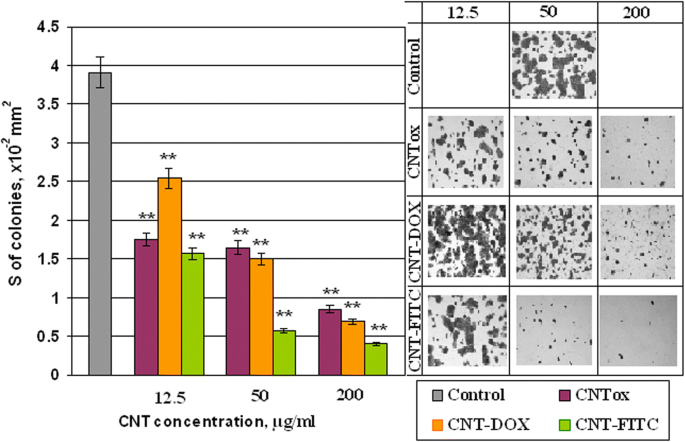
Die Fläche der Kolonien von HT29-Tumorzellen in Monolayer-Kultur, die mit CNTox (# 1), CNT-Dox (# 3), CNT-FITC (# 5) inkubiert wurde. Statistische Signifikanz:*р ≤ 0,05 oder **р ≤ 0.01
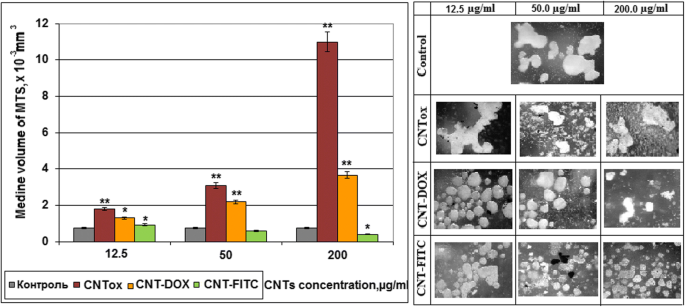
Der Median des Volumens der mehrzelligen Tumorsphäroide. MTS wurden in Gegenwart von CNTox (Probe #1), CNT-Dox (Probe #3), CNT-FITC (Probe #5) erzeugt. Statistische Signifikanz:*р ≤ 0,05 oder **р ≤ 0.01
Bemerkenswert ist, dass CNT-Dox in den meisten Experimenten weder in 2D- noch in 3D-Kulturen solche zytotoxischen Wirkungen auf Tumorzellen hat, die mit der Wirkung eines einzelnen Doxorubicins verglichen werden könnten. The mechanism of cytotoxic action of doxorubicin is based on penetration into the cell nucleus and intercalation between nucleotide pairs, violation of replication and DNA repair, protein synthesis and, as a result, cell death. The cause of the reduction of cytotoxic effect of the CNT-Dox may be the binding of the doxorubicin with CNT surface through peptide bonds. It prevents Dox dissociation from CNT surface and Dox penetration into the cell and cellular organelles. This fact may let to deliver the compound to certain tissues without causing a negative effect on “non-target” objects.
In this case, the next step of the study was controlled release of doxorubicin. For peptide bonds breaking, we used the commonly known peptidase trypsin as the release agent. The effect of trypsin on the Dox release from the surface of the CNT was investigated by spectral analysis. Since the free doxorubicin has a fluorescence peak at 495 nm, bounded doxorubicin has no such ability. It was analyzed how the increasing of trypsin concentration affected on concentration of free doxorubicin. The results are shown in our previous work [42]. Shortly, it was demonstrated that increasing the concentration of 0.05% trypsin from 11 to 20% in culture medium contributed to an increasing the concentration of free doxorubicin from 3.13 to 6.55 μg/ml. A further increasing the concentration of trypsin to 60% did not lead to increasing in free doxorubicin. However, the concentration of trypsin by about 66% stimulated release again and led to increasing the concentration of doxorubicin in two times, to 11.38 μg/ml. Thus, it was concluded that 0.05% trypsin has several effective concentrations. Under these conditions, peptide bonds between doxorubicin and CNT were broken and doxorubicin was released. Therefore, to analyze how CNT-Dox influence the tumor cells after Dox release, we incubated tumor cells in the w/o fetal bovine serum (FBS) nutrient medium with trypsin and in the presence of CNT-Dox. The survival of tumor cells was determined using the MTT test. The ratio of the nutrient medium, trypsin, concentration of CNT-Dox, and doxorubicin are given in Table 2. The results of incubation HT29 during 48 h are demonstrated on Fig. 8. Cell viability in the presence of trypsin—blue columns, alone doxorubicin—orange columns, and CNT-Dox with trypsin—pink columns. In results, it has been found that the simultaneous use of trypsin and CNT-Dox significantly increased the cytotoxic effect of CNT and doxorubicin compared to the separately use of these substances. So doxorubicin alone at concentrations from 0.05 to 1.0 μg/ml causes a dose-dependent decreasing the percentage of living HT29 cells from 7.18 to 45.7% relative to control (Fig. 8, orange columns). Incubation of CNT-Dox at concentrations of 20.0 to 1.25 μg/ml with trypsin at concentration from 0 t0 70% led to a dose-dependent decreasing in the percentage of living cells from 80.9 and 99.8% respectively (Fig. 8, pink columns). At the same time, incubation with trypsin alone leads to decreasing percentage of living cells only by 34.0–42.0% (Fig. 8, blue columns). Thus, we can conclude that we observe the synergistic effect of CNT-DOX and trypsin. Each individual component has a small cytotoxic effect on cells, and together the cytotoxic potential of substances increases several times.
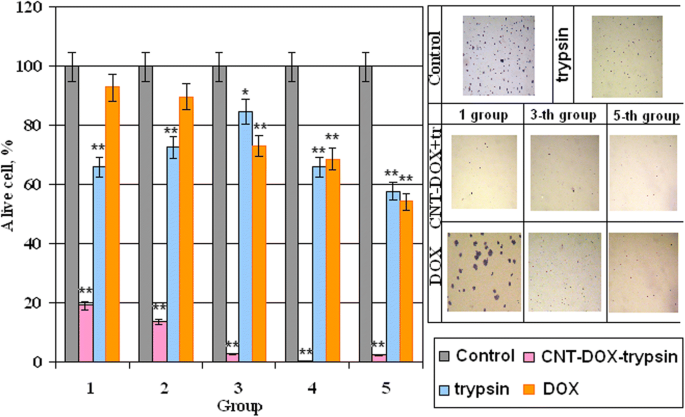
Percentage of alive cells HT29 after 48 h of incubation in the presence of trypsin, doxorubicin, CNT-Dox. Statistical significance:*р ≤ 0.05 or **р ≤ 0.01
As functional groups (Dox) were attached to CNTs surface by peptide bonds as, in vivo Dox release will be realized in organs of the gastrointestinal tract with an increased content of proteases, peptidases. In organism, proteases are used for various metabolic processes. Acid proteases secreted into the stomach (such as pepsin) and serine proteases present in duodenum (trypsin and chymotrypsin) enable us to digest the protein in food [43]. Other proteases are present in leukocytes (elastase, cathepsin G) and play several different roles in metabolic control. This is one of the fastest “switching on” and “switching off” regulatory mechanisms in the physiology of an organism. By complex cooperative action, the proteases may proceed as cascade reactions, which result in rapid and efficient amplification of an organism’s response to a physiological signal. Therefore, the authors suggest that CNT-Dox construction will be the most effective in the case of stomach, pancreas, liver, and small intestine cancer localization in case of parenteral administration of drug.
Influence of CNTs and Their Derivatives on Cell Blood Composition, Hepatic Enzyme System, and Proteins Turnover In Vivo
To determine the impact of the CNTox and CNT-Dox on the protein metabolism and the state of the hepatic enzyme system, the level of albumin (Al), total protein (Tp), alanine aminotransferase (ALT), aspartate aminotransferase (AST), and alkaline phosphatase (ALP) was determined. Data are given in Fig. 9a, b. As a result, it was noted that CNT-Dox and Dox have influence on the hepatic enzymes activity, namely on the AST and ALP. AST level increased in mice serum from 1 group for 21.6%, 2 group for 93.9%, and 3 group for 126.4% compared with control. At the same time, the activity of ALP increased in mice serum from 1 group for 23.5%, 2 group for 119.1%, and 3 group for 147.8%. CNTox administration did not show statistically significant changes in AST, ALT, and ALP levels. In addition, it should be noted that CNTox, Doxorubicin, and CNT-Dox slightly increased the level of total protein in the blood of experimental animals. So, we found that systematic introduction of CNTox have not influence on mice serum enzyme profile. And opposite, administration of CNT-Dox and Dox had toxicity influence and induced a chronic hepatic damage. Notably, symptoms of hepatitis had more manifestation after Dox treatment than CNT-Dox. To determine possible inflammatory processes and systemic effects of CNTox, CNT-Dox on the state of blood cells composition, it was analyzed the blood cell formula of the experimental animals. The results are shown in Table 3. Obtained data are in good agreement with the well-known manifestations of doxorubicin’s hematological toxicity:anemia (decreased red blood cells, hemoglobin, hematocrit), thrombopenia (platelet count), neutropenia (decrease in the number of granulocytes). Interestingly, that it was demonstrated the same direction of the changes of practically all hematological parameters in the 1 (CNTox), 2 (CNT-Dox), and 3 (Dox) groups of animals. However, the change in the 2 and 3 groups of animals was statistically significant accordingly to control and 1 group. In the 2 group (CNT-Dox), it was found pronounced decreasing of the monocyte content related to the system of phagocyte mononuclear cells and cell’s immune response (9.5% and 0.12 × 10 9 /l in control, 4.6% and 0.06 × 10 9 /l in 2 group, and 4.55 and 0.05 × 10 9 /l in 3 group). Animals of 2 and 3 groups demonstrated reducing the content of granulocytes (neutrophils) (12.6 and 0.16 × 10 9 /l in control and 8.5% and 0.2 × 10 9 /l in 2 group and 8.05 and 0.16 × 10 9 /l in 3 group). The number of lymphocytes, both in percentage and absolute, increased in 2 and 3 groups (77.9% and 0.97 × 10 9 /l in control and 86.9% and 2.0 × 10 9 /l in 2 group and 87.8% and 2.3 × 10 9 /l in 3 group). The main function of the lymphocytes is recognition of the antigen and participation in the adequate immunological response of the body. T lymphocytes perform regulatory and effectors functions. B lymphocytes take part in humoral immunity, providing immunoglobulins in response to stimulation of other people’s antigens. So, it can be assumed that an increase in the index of lymphocyte content in experimental 1, 2, and 3 groups can be associated with the introduction of foreign antibodies (CNTs) and/or tissue distraction [44]. Some decrease in the absolute number of leukocytes in 2 (1.2 × 10 9 /l) and 3 (0.85 × 10 9 /l) groups compared with the 1 group of animals (2.0 × 10 9 /l) can be regarded as the result of a gradual accumulation of the reversal of toxic effects of Dox. It is described the reaction of WBC in experimental animal groups as well-known toxic hematologic impact from doxorubicin in the development of leucopenia. The analysis of indicators reflecting the number and state of RBC (erythrocytes and hemoglobin) also showed the same trend of misbalance in the 2 and 3 groups of animals. Statistically significant thrombocytopenia and anemia are more indicative in animals of 2 and 3 groups:the number of erythrocytes (5.54 × 10 12 /l in control, 3.97 × 10 12 /l in 2 group, and 3.12 × 10 12 /l in 3 group), the amount of hemoglobin (78 g/dl for intact animals, 55.5 g/dl for 2 group, and 46.2 g/dl for 3 group), hemoglobin (25.25% for intact animals and 16.75% for 2 group and 15.12% for 3 group). The amount of erythrocytes decreased but the average content of hemoglobin in one erythrocyte did not decrease. And, as a result, concentration of hemoglobin per one erythrocyte increased. Analysis of the RBW counts let us suggest that in 2 and 3 group of animals, there are several processes:decreasing the formation of erythrocytes in the bone marrow, the acceleration of erythrocyte destruction, the violation of the structure of membranes of red blood cells, and molecular defects (oxidation) of hemoglobin. Thrombocytopenia (27 × 10 9 /l in intact animals, 14.0 × 10 9 /l in 2 group, and 12.05 × 10 9 /l in 3 group), a dose-dependent reversible myelosuppression, leucopenia and granulocytopenia (neutropenia) are the predominant manifestations of doxorubicin hematologic toxicity and is the most common acute dose-limiting toxicity of this drug. The direction of changes in the platelet content in the blood of experimental animals treated with CNTox and CNT-Dox is the same; however, significantly more pronounced in the group of animals receiving free Dox.
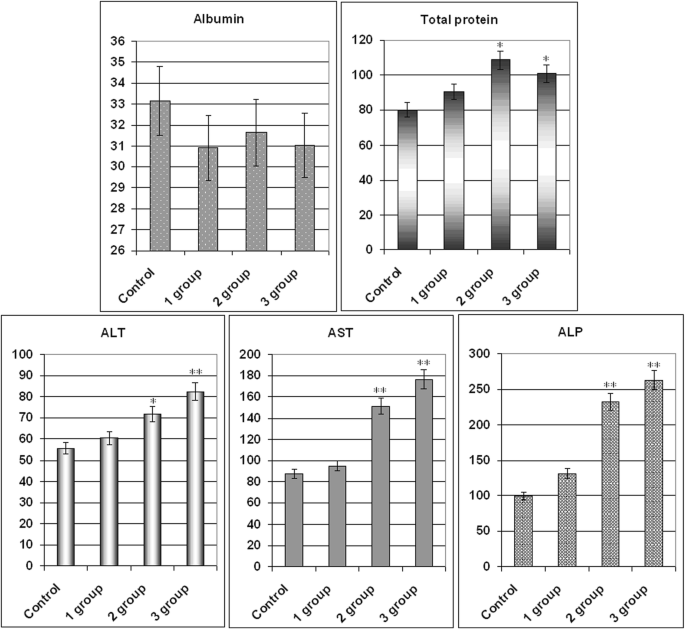
Monitoring of clinical parameters following CNTox (1 group), CNT-DOX (2 group), free DOX (3 group) administration in Balb/2a mice. Mice were treated by CNTox, CNT-DOX, DOX every 3 days during 4 weeks, in concentrations:CNT—1.5 g/kg and Dox—20 mg/kg of weight. Each experiment was done in triplicate. Statistical significance:*р ≤ 0.05 or **р ≤ 0.01. ALT alanine transferase, AST aspartate transferase, AP alkaline phosphatase
Thus, according to our results from in vivo experiments, it was demonstrated that systematic introduction of CNTox have not influence on mice serum enzyme profile and protein turnover. And opposite, administration of CNT-Dox and Dox had toxicity influence and induced a chronic hepatic damage. More than that, dose-dependent reversible myelosuppression, leucopenia, and granulocytopenia (neutropenia) was shown for the group of animals receiving free Dox. This predominant manifestation of hematologic toxicity was less pronounced in the group of animals receiving free CNT-Dox and CNTs. So, we can assume that, in the case of parenteral administration of CNT-Dox under action of gastric juice peptidases, CNT-Dox particles breaks up into free CNT and Doxorubicin. After that, Doxorubicin enters to the stomach cells and partly in the bloodstream. That also causes the specified effect on blood cells composition. For modeling Dox release in vivo, trypsin were used in vitro.
One of the goals of this investigation was to minimize the side effects of carbon vehicle on the body. Previously, the authors demonstrated that CNTs may be a potential threat to tumor development due to its ability to stimulate cell migration and support cells in suspension fraction [33]. In this case, CNTs themselves play a role of artificial extra cellular matrix. Another way CNTs can stimulate suspension cells to aggregation. If this process will be coincident with antitumor drug accumulation on CNTs surface, CNTs will attract substrate-independent cells and kill them. Simultaneously, it was found that pure CNTs did not have statistically significant cytotoxicity to tumor cells. So, CNTs alone are not dangerous as cytotoxic agents and can act as carrier for antitumor drugs to target cells. Then, studies were conducted to the functionalization of the CNTs by antitumor antibodies. It was demonstrated that CNTs are able to carry on the surface not only the Dox but also specific tumor antibodies—anti EGFr [42]. Under the action of trypsin, Dox was released and realized strong cytotoxic effect on tumor cells. Recent studies have shown the synergy cytotoxic effect of CNTs and Doxorubicin after release from CNT-Dox construct in the presence of trypsin. Such effect was not demonstrated by CNTs and Dox separately. Therefore, the benefits from the use of CNTs seems in the usage CNTs as vehicle for antitumor antibody and drug. On the other hand, the negative effects of Doxorubicin, like many other early antitumor drugs, are totally cytotoxic effects. Binding of the Dox to the CNTs partially blocks it. This effect allows ensuring local accumulation of the Dox in the focus of tumor activity with subsequent release and action. Thus, greater efficacy can be achieved with a smaller dose of administration. This effect can be achieved only if there are tumor-specific antibodies on the surface of the CNTs. The possibility of creating such construct was demonstrated by the authors in previous work. Undoubtedly, that CNTs dissemination, accumulation, and Dox effective should be tested on mixed culture in vitro and on a tumor model in vivo. For this purpose, synthesized CNT-FITC was created and conducted. The ability of the CNTs to act as an extra-cellular matrix and the significance of this process for the “tumor-body” system should be tested on the animal model. The effectiveness of the drug will be investigated on the model of Ehrlich carcinoma and colon rectal carcinoma [44]. The distribution of CNTs in the tissues of the body will be investigated using the construct created by the CST-FITC, as was mentioned in this work. The accumulation of CNTs in the tissues of the organs of the gastrointestinal system, namely the stomach, liver, and intestines, will be analyzed by histological assay. These studies are already conducted by the authors.
According to Shang-Lin Wang [4] and our data, free doxorubicin causes similar side effects, but more pronounced than CNT-Dox. Other authors reported that toxicity effect of CNTs depends on way of administration, dose, and time of exposure and varies according to the size and type of the cells [45,46,47,48,49]. Settling of CNTs in the tissues of the liver, kidneys, and stomach with prolonged exposure can cause oxidative stress, DNA damages, compromise cell proliferation, necrosis of tissues, and chronic inflammation [50]. According to Manna [51], CNTs can cause oxidative stress and compromise cell proliferation. In the case of in vitro studies, the cytotoxicity of CNT highly depends on the degree of CNTs purification, functionalization, size, and surface charge [52,53,54,55]. According to our results and previous data, the obtained CNTs did not demonstrate a significant cytotoxic effect [33]. More than that, our data let us suggest that there is a combined cytotoxic effect of CNTs and DOX that occurs as in vitro. That is why we assumed that obtained CNTs can be used against tumor cells, in case of the target accumulation of CNTs/CNT-Dox in tumor tissue. However, mechanisms of the cytotoxic effect of CNTs are not completely clear. Some authors suggested that CNT particles activate NF-kappaB pathway depending on the dose and that the mechanism of activation was due to activation of stress-related kinases [51]. Other authors reported that CNTs have a direct pro-apoptotic effect in vitro in different cancer cell lines and tumor cells obtained from surgical specimens [56], CNTs able to modify fatty acids in cell membranes [57] or erythrocyte membrane damage [58]. For further investigation of accumulation CNTs in cells and tissue, we plan to use CNT-FITC composite.
Other unclear questions are as follows:what is the prolonged impact of CNTs/CNT-Dox on organism level and how does it stimulate accumulation CNTs/CNT-Dox in tumor tissue? To investigate the influence of chronical introduction of CNTs/CNT-Dox, long-time studies on model of transplanted or initiated tumors of various localizations will be realized. Other authors analyzed the distribution of nanotubes throughout the body of mice after pulmonary exposure [59]. In results, accumulation of MWCNTs was documented in several organs, including notably the white pulp of the spleen and the bone marrow. The CNTs usually deposit in the liver, spleen, or lungs after they have served their purpose from where they are expelled gradually out of the body through the renal excretion route [60]. Zhao and Liu reported that accumulation of CNTs in the body can lead to granulomatous inflammation or alveolar septal thickening. Zhuang Liu et al. reported that SWNT-PTX affords higher efficacy in suppressing tumor growth than clinical Taxol® in a murine 4T1 breast-cancer model, owing to prolonged blood circulation and tenfold higher tumor paclitaxel (PTX) uptake by SWNT delivery likely through enhanced permeability and retention [61]. Accumulation of CNTs in the target tissue can be enhanced by placing on the CNTs surface specific antibodies which over expressed by tumor cells. The possibility of using antibodies for the targeted delivery of nanostructured preparations has been described by many authors [62, 63].
Schlussfolgerung
In 2D culture CNTox concentration from 25 to 50 and 100 μg/ml led to dose-dependent decreasing the viability of tumor cells to 71.8–69.6–62.5% accordingly compared with control. At concentration of CNTox up to 200 μg/ml, the viability of HT29 decreased to 39.2%. At that time, CNT-Dox at concentrations 12.5–25–50 μg/ml did not show statistically significant cytotoxicity, compared with CNTox. At high concentrations (200 μg/ml), CTN-Dox had even less cytotoxicity than CNTox (50%). After incubation with CNT-FITC in concentration of 25 μg/ml, HT29 cell survival reduced to 55% and at 100–200 μg/ml to 23 and 7% respectively. In 3D culture, increasing of CNTox concentration is accompanied with dose-dependent increasing of median volume of MTS. At concentration CNTox from 12.5, 50, 200 μg/ml median volume of MTS increases from 1.79 to 2.18 and 10.98 mm 3 . CNTs-Dox and CNT-FITC did not cause such effect on tumor cells. Doxorubicin alone at concentrations from 0.05 to 1.0 μg/ml causes a dose-dependent decrease in the percentage of living HT29 cells from 7.18 to 45.7% relative to control. Incubation CNT-Dox at concentrations of 20.0 to 1.25 μg/ml with trypsin at concentration from 0 to 70% led to a dose-dependent decreasing the percentage of living cells from 80.9 and 99.8% respectively. At the same time, incubation with trypsin alone leads to decreasing percentage of living cells only by 34.0–42.0%. So, the synergistic effect of CNT-DOX and trypsin was observed. Each individual component has a small cytotoxic effect on cells, and together the cytotoxic potential of substances increases several times. In vivo, systematic introduction of CNTox have not influence on mice serum enzyme profile. And opposite, administration of CNT-Dox and Dox had toxicity influence and induced a chronic hepatic damage, thrombocytopenia, a dose-dependent reversible myelosuppression, leucopenia, and granulocytopenia (neutropenia). Notably, symptoms of hepatitis had more manifestation after Dox treatment than CNT-Dox.
So, the possibility of targeted delivery and controlled release of any highly toxic drug with the use of CNT depends on strategies of reducing toxicity of CNTs and realizing potential of CNTs and anti-tumor drugs “in right place in right time.” According to the data obtained by authors and literature, it is possible. Our data support the assumption that this approach allows to reduce toxicity of the doxorubicin on the general biochemical indicators of blood and violations in the blood cells composition. At the same time, doxorubicin releasing is realized under certain conditions. And combined effect of CNTs and doxorubicin let us achieve greater efficacy in suppressing tumor cell growth in vitro.
Abkürzungen
- Al:
-
Albumin
- ALP:
-
Alkaline phosphatase
- ALT:
-
Alanine aminotransferase
- AST:
-
Aspartate aminotransferase
- CNT-Dox:
-
Carbon nanotubes which were functionalized by doxorubicin
- CNT-FITC:
-
Carbon nanotubes which were functionalized by fluorescein
- CNTox:
-
Oxidized carbon nanotubes
- CNTs:
-
Kohlenstoff-Nanoröhrchen
- Dox:
-
Doxorubicin
- FTIR:
-
Fourier-Transformations-Infrarotspektroskopie
- MTS:
-
Multi-cellular tumor spheroid
- MWCNTs:
-
Multi-walled carbon nanotubes
- PTX:
-
Paclitaxel
- Tp:
-
Total protein
Nanomaterialien
- Herstellung und Bildgebung von Cyclocarbon
- Elektrodeposition von SnO2 auf FTO und ihre Anwendung in planaren Heterojunction-Perowskit-Solarzellen als Elektronentransportschicht
- In-vitro-Studie zum Einfluss von Au-Nanopartikeln auf HT29- und SPEV-Zelllinien
- Biosicherheit und antibakterielle Wirkung von Graphen und Graphenoxid in vitro und in vivo
- 5-Aminolävulinsäure-Squalen-Nanoanordnungen für die Tumorphotodetektion und -therapie:In-vitro-Studien
- Magnetischer Goldnanopartikel-markierter monoklonaler Heparanase-Antikörper und seine anschließende Anwendung für die Tumor-Magnetresonanztomographie
- Einfluss von in einer TiO2-Kompaktschicht eingebetteten Ag-Nanopartikeln unterschiedlicher Größe und Konzentration auf die Konversionseffizienz von Perowskit-Solarzellen
- Die Auswirkungen inhalierter mehrwandiger Kohlenstoff-Nanoröhrchen auf den Blutdruck und die Herzfunktion
- Die toxische Wahrheit über Kohlenstoff-Nanoröhrchen in der Wasserreinigung:eine perspektivische Ansicht
- Antiproliferatives und Apoptose-auslösendes Potenzial von Paclitaxel-basierten Targeted-Lipid-Nanopartikeln mit verbesserter zellulärer Internalisierung durch Transferrinrezeptoren – eine Studie in …



